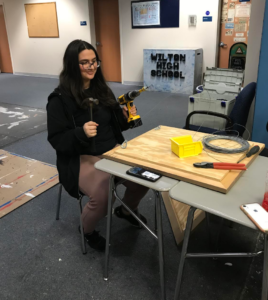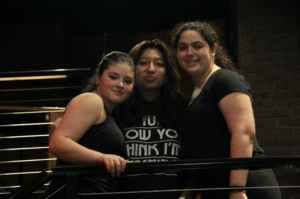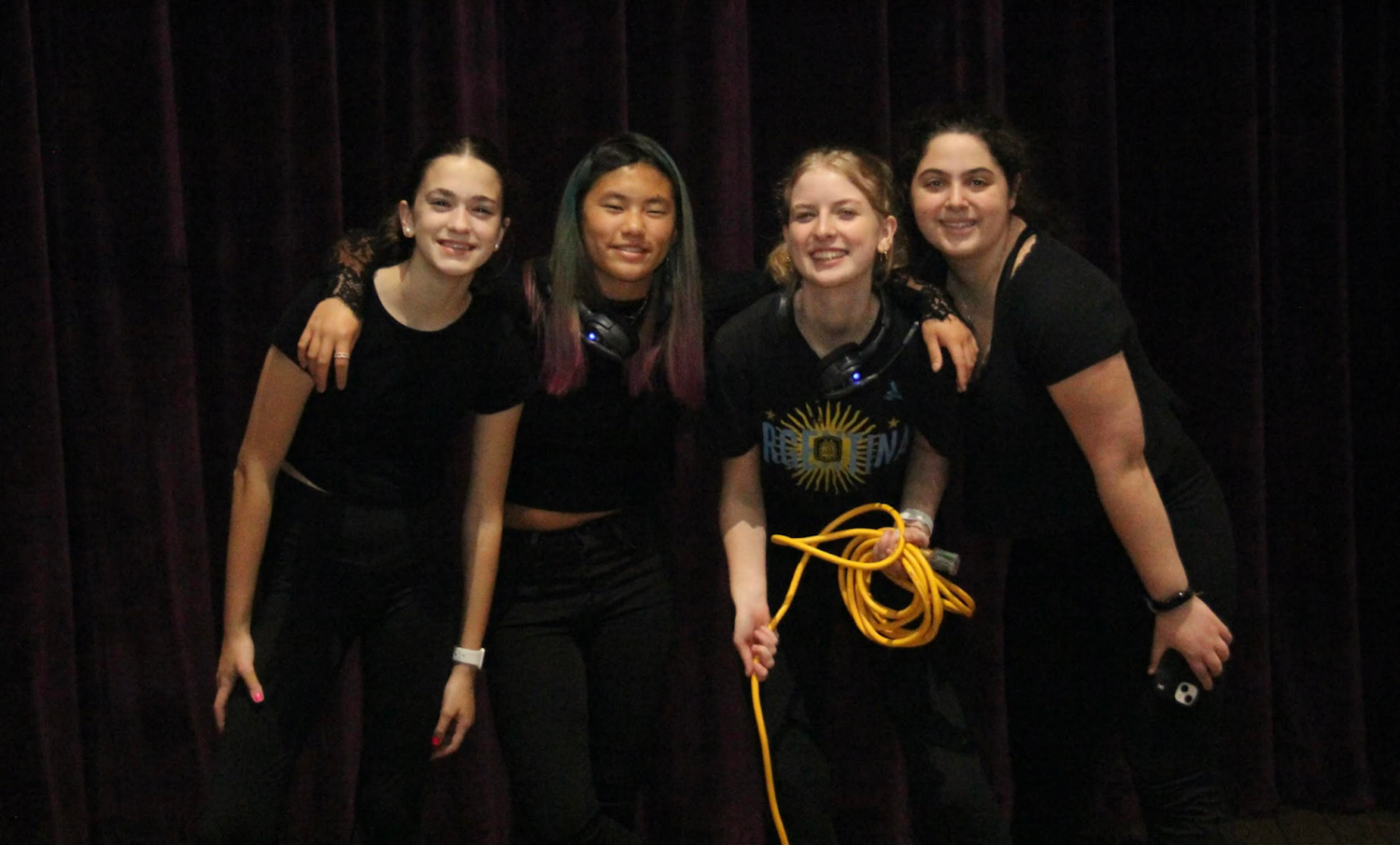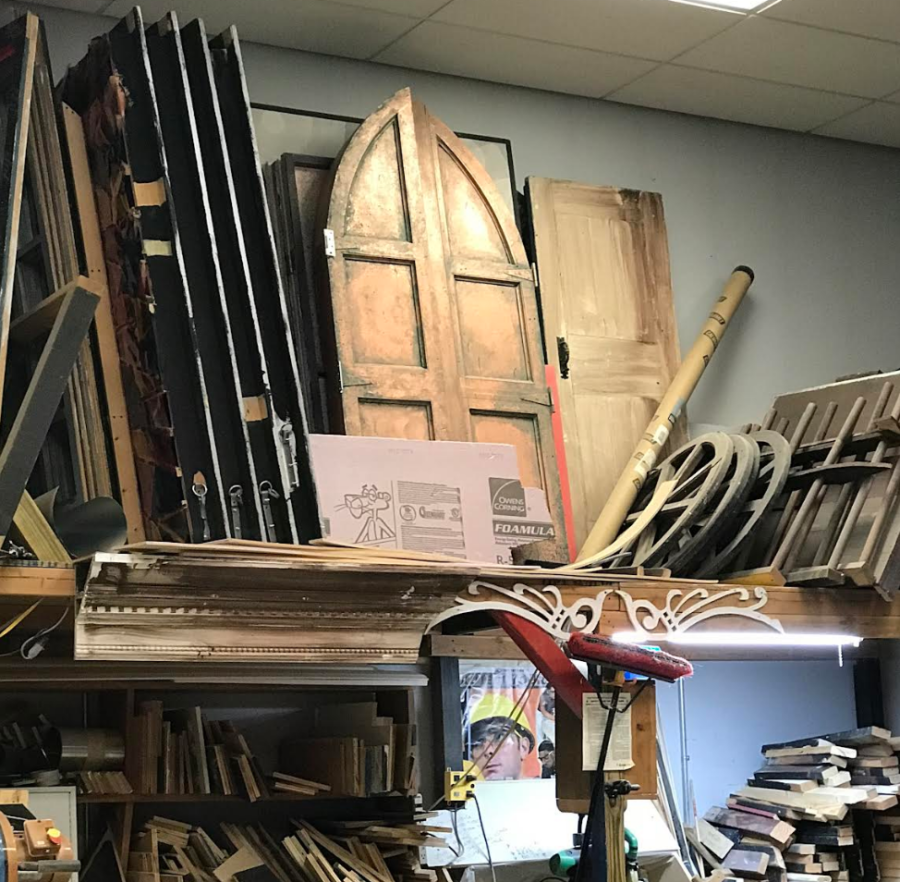Yana Giannoutsos is a senior at Wilton High School. She is honored to be Co-Editor-in-Chief of the Forum. She has a passion for all genres of writing and is thrilled to display her passions, opinions, and thoughts through writing about the Wilton High School community this year. In her free time, Yana is either running, practicing yoga, or reading a good book.
Stage Crew: Behind the Spotlights
How They Made “The Play That Goes Wrong” Go Right
November 26, 2022
There is more to a production than the actors on the stage. Between the intricate set pieces and the talent of the actors, WHS theater can proudly- and rightfully- boast a great program. But there is a whole world off-stage where workers take pride in making both plays and musicals possible. These stars deserve the spotlight, too.
The unsung heroes of a production live backstage. They control the spotlights, move the set pieces, and quite literally hold the actors’ lives in their hands. Though sometimes underestimated, the stage crew’s work merits appreciation, especially because no one really knows what this physically and mentally grueling—yet gratifying—job entails. They make sure the spotlight shines on the actors; let’s shine the light backstage!
Kate Rusin, stage manager for the fall play and Spring musical as well as prop master for this year’s Fall play, “The Play That Goes Wrong”, discussed the production process for crew members.
“Stage management starts from the audition process. We help run the auditions and make sure we get everyone’s information. Basically, we do all the organizational stuff and the admin. And then once rehearsals get going and the show is cast, the stage crew begins working tech and building in the workshop.”
Each show performed exists on a continuum. The workshop, a storage room adjacent to the Clune Center, serves as a visual representation of the history of WHS productions. Housing all set items from previous productions, the workshop enables the stage crew to recycle props and building materials from previous productions (with a wide selection of set pieces from 21 plays and 20 musicals) and reinvent them for each new production. A towering yet secluded room, the workshop goes unnoticed by the majority of the school body. A walk into this astonishing epicenter of the WHS theater world, though, would make anyone amazed. An endless display of walls used in previous plays adorns the back wall of the workshop while the center table has power tools and fresh wood for constructing new scenery. Bookshelves that have been painted over and reused, as well as entire staircases (like that used in the Spring Musical of 2022: “Legally Blonde”), show a robust history of productions, as well as the versatility of each piece of scenery. Certain set pieces have been in circulation since the school’s first production in 1999.
For the stage crew, plans for the next play begin even before the cast takes their final bows. “The beginning of a production,” Rusin said, “is when we start taking apart and building from the last production and then we start building according to Mr. Planton’s instructions.”
This day, known to the theater industry as “strike day”, involves tearing down the set, cleaning the theater, and returning it to its unadorned, original state. Though both chaos and destruction ensue, organizing this exhilarating demolition lies in the hands of the stage crew.
Mr. Planton, the set designer, facilitates this entire process. Since the beginning of WHS’s history of productions, he has played a critical role in training the stage crew and catering the set to each production, gaining an impressive repertoire.
“Mr. Planton reads the script before every production multiple times and designs the set based on the script, which involves the color schemes, and the actual physical architecture of the set beforehand, and he directs all of the techies and parent volunteers to help construct and paint the set,” Rusin said. “He has worked professionally for different corporations and studios so he has a lot of experience and a lot of good stories to tell about working in the industry.”

Yana Agoeva, workshop builder and spotlight manager, joked: “He lets me use a hammer and a drill, which my own mother doesn’t let me.”
Mr. Planton puts an immense amount of trust in the stage crew, which they earn from hours of training and preparation. Stage Crew members stay after school every week for at least three hours (6:00-9:00 PM) Monday through Thursday for two to three months during rehearsals for each production. With a rigorous schedule and grueling time commitment, the crew quite literally eats, sleeps, and breathes theater.
Historically, cast members and crew have shared an infamous rivalry. While this norm surely does ring true in some communities, WHS theater defies the status quo.
“There is a lot of stigma around the relationship between the crew and the actors. Questions like: “Does the crew hate the actors?” or “Do the actors hate the crew?” often arise, but neither is true here. We are all friends with the cast and the cast is friends with us,” Rusin said.
The program can only foster this camaraderie by giving the members time to interact and solve problems together.
“The bond just naturally happens,” said Jacki DiCenzo, a member of the run crew and spotlight crew. “In this environment, you work so closely you can’t help but be friends with them.”
Involvement in the crew exposes members to a variety of individuals, each of whom possesses a different proclivity, whether building, running, or shining spotlights: all jobs that viewers never get to see.
Recently, the stage crew community has shed light on the issue of their underrepresentation. “Nobody knows about us until we come out at the end and bow. People don’t even know we exist,” Agoeva said.
In most viewers’ theater experiences, they go through the show without hearing any acknowledgment of the stage crew, even despite the grueling work and sleepless nights they’ve endured to make the production happen.
“Historically, actors get curtain calls every performance, but the crew only goes up for the last performance. I don’t think that’s necessarily fair. If you’re going to do it one night, you might as well do it all of the nights!” Rusin said. “I petitioned the producer and the director last year before legally blonde performed and basically pleaded my case and told them why I thought Crew should get bows every night.”
After weeks of petitioning and receiving hesitant responses from people denying the importance of this issue, Rusin, along with other stage crew members, continued to fight for this cause. Upon bringing the issue to the attention of the powers that be, she “got a very positive response from the director and the producer. It was very nice to have that support so we got bows all four nights of legally blonde and that was very gratifying and really fun.”
The biggest issue is not a lack of representation. It’s a lack of information. Since no one really knows the extent of the crew’s work, it goes unnoticed. This year, though, the tides have turned. After adding nightly bows and advertising for more stage-crew involvement, members have erased part of the stigma.
I think a lot of people think that we do crew because they are scared of the spotlight, but I do crew because I love the atmosphere of crew.
— Kate Rusin
The misconception that the stage crew is reserved for stage-shy individuals dilutes its significance. The people behind the scenes want to be there. They take pride in creating a production, even if their name doesn’t end up at the top of the playbook.
“Some people like putting other people on [the] spotlight. It’s not a bad thing. It’s a fun thing to do, and I think people need to learn that skill,” Agoeva said. “Stage crew really taught me to let someone else have the spotlight. But I also want to be thanked for all the work.”
The term “work” may be an understatement. Behind the scenes of a play and during rehearsals, the crew must control all the moving pieces- literally- and address any hiccups. To acquire this skill, though, each member undergoes training just like the actors rehearse scenes.
“The set movement and the prop movement is just as choreographed as the actors are,” Rusin said. “I know the general gist of the play because the stage managers have to know the show backward and forwards to make sure everything’s going safely.”
Ensuring that all the props and set pieces are in the right place demands patience and intelligence. “We basically babysit the cast backstage as well, making sure that they are where they’re supposed to be,” Rusin said. “The crewmembers are actually responsible for keeping people alive and in check,” Agoeva said.
Anyone who saw “The Play That Goes Wrong” would know that a set requires constant care and caution. A play-within-a-play, this production told the story of a group of students and crew members who struggle to make it go smoothly. Between actors forgetting lines and set pieces falling at all the wrong times, it brought light to the process of putting on a production, while also delivering a comical portrayal of “The Murder at Haversham Manor”.
The elaborate set in this play, featuring a mobile grandfather clock, a couch, collapsable walls, and a stubborn mantlepiece, had to constantly be manipulated by actors playing the role of “stage crew”. During scenes, the actual crew kept track of the actors’ cues to adjust the set accordingly, signaling the actors to knock entire walls down from backstage as well as managing the movement of the actors and set pieces behind the scenes. Additionally, they had to figure out how to signal actors on stage to get out of the way as different pieces of scenery fell. The play humorously narrated virtually all aspects of a production that can crash and burn without the presence of a devoted stage crew, bringing tremendous awareness to the stage crew’s work as well as the critical nature of their interaction with both each other and the actors themselves.
“It is very important that everything that’s supposed to go wrong goes wrong in the right way because someone could get hurt very easily. Especially with the fly system, things can fall on them,” Rusin said.
“We are responsible for the actors’ safety. In the past we have to move stage pieces with actors on top, which is terrifying,” DiCenzo said. Surely, the crew once again met this challenge with grace and ease, making everything go perfectly wrong.

Looking at the theater community, it is evident that every contributor to the production forms part of the larger team. Despite their established bond, the stage crew especially wants to see new involvement. “A lot of people are intimidated by theater because it’s a very tight-knit community but at the same time it’s very easy to get involved and we need more people. Every year we need more people. It’s never too late to join Crew,” Rusin said. “We would love to have you.”
It takes a village, and the stage crew is the glue that holds the village together. Their dedication to enhancing the intricate sets behind every actor’s perfectly-delivered scene is admirable and often goes unnoticed. Step behind the spotlight, and you will see a force to be reckoned with.


